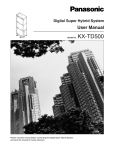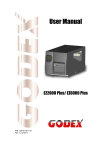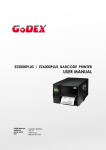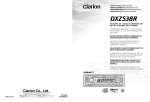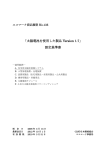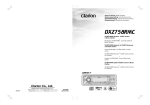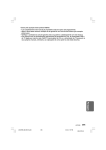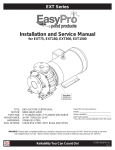Download Sigma V KT848 Installation guide
Transcript
Sigma V KT848 Business Telephone System Installation Guide (Release 1.1) CONTENTS I. System Overview ...............................................................................1 i. ii. iii. System Operation ........................................................................................ 1 System Configuration................................................................................... 1 Hardware Diagram....................................................................................... 2 1. Main Unit............................................................................................... 2 2. Power Supply........................................................................................ 2 3. Mother Board ........................................................................................ 3 4. 4 ports CO line board (CO 1~4) ............................................................ 3 5. 4 ports CO line expansion board (CO 5~8)........................................... 4 6. Caller ID board...................................................................................... 4 7. 8 ports Extension expansion board....................................................... 4 8. Feature phone ...................................................................................... 5 9. DSS Console ........................................................................................ 6 II. Specifications.....................................................................................7 i. ii. iii. iv. v. vi. III. System Capacity .......................................................................................... 7 Power Specifications.................................................................................... 7 Environmental Limits.................................................................................... 7 Cable Requirements .................................................................................... 7 Physical Dimensions and Weights ............................................................... 7 Peripheral..................................................................................................... 8 Installation....................................................................................9 i. ii. iii. iv. v. vi. vii. viii. ix. x. xi. Main unit installation ............................................................................. 9 Power Supply installation.................................................................... 10 Co line connection .............................................................................. 11 Station connection .............................................................................. 11 CO line expansion board installation................................................... 11 Extension expansion board installation............................................... 12 Caller ID board.................................................................................... 12 External Music-On-Hold installation .................................................... 13 External Speaker installation .............................................................. 13 SMDR installation ............................................................................... 14 Power Failure Transfer installation...................................................... 14 i IV. System Programming ................................................................16 i. ii. iii. iv. Numerical Program Overview .................................................................... 16 Alphabetical Program Overview................................................................. 17 Ways of using feature phone to access system programming: .................. 18 Ways of using the single line phone to access system programming: ....... 18 Program 00: Time and Date Settings...................................................... 19 Program 01: CO setting #1 ...................................................................... 19 Program 02: CO setting #2 ...................................................................... 20 Program 03: System speed dialing ........................................................ 20 Program 04: System setting #1............................................................... 21 Program 05: System setting #2............................................................... 21 Program 06: System setting #3............................................................... 22 Program 07: System setting #4............................................................... 22 Program 08: Night transfer...................................................................... 23 Program 09: Outgoing call setting (Day mode) ..................................... 23 Program 10: Outgoing call setting (Night mode) .................................. 23 Program 11: Incoming call setting (Day mode) ..................................... 24 Program 12: Incoming call setting (Night mode) .................................. 24 Program 13: Setting of delay ringing / DISA setting ............................. 24 Program 14: Class of Service ................................................................. 25 Program 15: Restriction code A ............................................................. 25 Program 16: Restriction code B ............................................................. 26 Program 17: Unrest code C..................................................................... 26 Program 18: Public restriction code D................................................... 26 Program 19: PBX access code ............................................................... 27 Program 20: Account code setting......................................................... 27 Program 21: DISA (Trunk-to-trunk transfer) access code setting ....... 28 Program 22: Extension setting #1 .......................................................... 28 Program 23: Extension setting #2 .......................................................... 29 Program 24: Pickup group assignment ................................................. 29 Program 25: Executor (Boss) /Secretary function ................................ 30 Program 26: System password............................................................... 30 Program 27: Special port setting............................................................ 31 Program 28: Initialize the system ........................................................... 31 Program 29: Extension number assignment ......................................... 32 Program 30: Unit price setting of international distance call............... 32 Program 31: Unit price setting of domestic distance call .................... 32 Program 32: Unit price setting of local call ........................................... 32 ii Program 33: Displaying of telephone charges ...................................... 33 Program 34: Review password of extension lock................................. 33 Program 35: Review system charge counting....................................... 33 Program 36: Presetting call charges...................................................... 34 V. Sample for special feature ...............................................................35 VI. Station Operation.......................................................................40 VII. Troubleshooting .........................................................................43 1.1 System down ............................................................................................. 44 1.2 Station Dial Tone Faults ............................................................................. 44 1.3 CO Line Dial Tone Faults ........................................................................... 44 iii I. System Overview i. System Operation Sigma V KT848 system is a stored program controlled electronic key telephone system ready to use as soon as it is turned on. A powerful microprocessor digitally controls all speech paths and system functions. The operating program with default memory is stored in non-volatile ROM. Customer data is stored in RAM and protected by a Ni-Cd battery for up to at least one month’s continuous loss of system power. When AC power is restored, the Ni-Cd battery will be recharged. ii. System Configuration Sigma V KT848 system has a basic capacity of 4 CO line ports and 16 extension ports, which can be extended to 8 CO and 48 extensions in maximum by adding optional expansion boards. This system can be used for both feature phones and single line phones. Extension ports 1 to 4 are assigned for either feature phone or single line phones. The extension ports can be connected with single line phones as well as faxes, recording machines and cordless phones etc. Sigma V KT848 system has three kinds of expansion boards: y 4 ports CO line expansion board (1 pc. expandable at max.) y 8 ports Extension expansion board (4 pcs. expandable at max.) y 7 ports Caller ID board (1 pc. at maximum) Combining the strapping options of basic KSU with all the combinations of expansion boards, Sigma V KT848 system is extremely flexible. The maximum numbers of each circuit type available in a fully configured Sigma V KT848 system are listed below. Circuit Type Maximum Number Available Feature Phone 4 Single Line Phone 48 (if no any feature phone) CO Line (Loop Start) 8 Remarks: Two features will reduce the system capacity: 1. Caller ID occupy 1 CO port 2. DISA Trunk-to-Trunk occupy 1 Ext port Page 1 iii. Hardware Diagram 1. Main Unit 2. Power Supply Page 2 3. Mother Board (1) (2) (3) (4) (5) (6) (7) (8) (9) (10) (11) 4 ports CO line board terminal (CO 1~4) 4 ports CO line expansion board terminal (CO 5~8) 8 ports Extension expansion board terminal (017~024) 8 ports Extension expansion board terminal (025~032) 8 ports Extension expansion board terminal (033~040) 8 ports Extension expansion board terminal (041~048) Jumper for internal/external music selection External music input for MOH External paging output Parallel interface (Printer) Serial interface (PC) 4. 4 ports CO line board (CO 1~4) Page 3 5. 4 ports CO line expansion board (CO 5~8) 6. Caller ID board 7. 8 ports Extension expansion board Page 4 8. Feature phone (1) Handset (2) LCD display (3) Flexible/function buttons: red/green LED indicators Button 1~8: Co line Button 9~32: One touch key for station or outside telephone number Button 33: FNC Button 34: CLEAR Button 35: DND Button 36: SCROLL (4) Dial pad (5) Panel display light switch (6) Fixed buttons / : Volume up / down (7) Handset socket (8) Telephone set socket (9) DSS1 terminal (10) Not use (11) Microphone (12) Speaker Page 5 9. DSS Console (1) DSS button Button 1~48:extension port 001~048 Button 49~64: not use (2) DSS terminal Page 6 II. Specifications i. System Capacity A maximum of 56 ports: the sum of CO/PBX lines and extension lines. Basic: 4 up to 8 CO/PBX lines (Loop Start, 600 ohms) 4 Feature phones 16 up to 48 Single line phones Additional: 3 Speech Paths 2 Audio Channels for Music (One of Internal Melody and the other of External) 1 Audio Channel for External Speaker ii. Power Specifications Power supply voltage: Maximum power consumption: Cross-talk attenuation: Transmission loss: Battery backup supply: iii. 180 VAC to 264 VAC, 50/60 Hz 80 W 70 dB 0.37 dB 24VDC Batteries rating not less than 7Ah but not more than 40Ah Environmental Limits Operating temperatures: Operating humidity: 0 °C to 45 °C (32 °F to 113 °F) 10% to 95% without condensation iv. Cable Requirements Feature phone: Maximum 100m (2 pairs twisted wire 0.5@) Single line phone: Maximum 1,000m (1 pair twisted wire 0.5@) v. Physical Dimensions and Weights Key Service Unit: 485mm W x 300mm H x 110mm D, 10.0Kg Feature phone: 230mm W x 95mm H x 210mm D, 1.0Kg 66-Key Direct Access Console: 230mm W x 80mm H x 160mm D, 1.0Kg Page 7 vi. Peripheral SMDR Communications: Source of music: Sound amplification output: 1,200 baud rate, 8-N-1 Input impedance: 600 ohms Input audio level: generally 250MV, virtual value 1V at the most Input impedance: 600 ohms Input audio level: generally 250MV, maximum 400MV Page 8 III. Installation System installation is shown as below: i. Main unit installation Remark: - Make sure that have enough space to open the cover of Main Unit, switch on/off power and make a connection with parallel interface - Measure the length between two holes for wall mount, and then drill and put it on the wall - Put the ground terminal connect to earth through ground wire Page 9 ii. Power Supply installation There are 2 kind of power supply –Type1) Standard Type2) Specify for backup battery. Type1) Standard (1) AC input of Transformer (2) AC output of Transformer which plug-in to (3) 1. Yellow wires – 70 VAC 2. Blue wires – 14 VAC 3. Black wires – 26 VAC (3) AC input of Linear power panel terminal (4) DC output of Linear power panel plug-in to main board z Pin 1 & 2 – 70 VAC z Pin 1 & 3 – 5 VDC z Pin 1 & 4 – 12 VDC z Pin 1 & 5 – 30 VDC (5) Power LED terminal Type2) Specify for backup battery (1) Same as (1) of Type1 (2) AC output of Transformer which plug-in to (3) z Black wires – 30 VAC (3) Same as (3) of Type1 (4) Same as (4) of Type1 (5) Same as (5) of Type1 (6) Backup battery input Page 10 iii. Co line connection iv. Station connection Feature phone (Remark: max. 100m length between extension port and telephone set socket) Single line phone (Remark: max. 1000m length between extension port and telephone set socket) v. CO line expansion board installation Page 11 vi. Extension expansion board installation vii. Caller ID board Page 12 viii. ix. External Music-On-Hold installation External Speaker installation Page 13 x. SMDR installation Pin assignment of (2): xi. KSU 2 3 7 → → → PC 3 2 5 Power Failure Transfer installation Page 14 Notes 1. The Sigma V KT848 system should be installed in a place away from vibration and moisture, which is clean, dry and ventilated. Do not either put sundries on the KTU or block its vent hole. 2. While you are wiring the extensions, it is a good idea to mask the wires off the power line and other high frequency links or keep them at least 1m away. 3. When the crystal heads (RJ11) of all the extensions are compressed, please check whether the heads are properly connected to the telephone lines to make sure all the contacts work properly and whether the crystal heads and their bases are loose or not. 4. The feature phone is provided with one connecting line of four cores; if you want to make it longer, please be careful with the order of the four cores, where the two in the middle are for signaling and the two in both sides for data transmission. If you need to add more crystal heads for joints, please refer to the diagram (if the operating distance of the feature phone connecting line is less than 100m, while compressing the crystal heads for joints, you must disconnect the connecting line from the host). 5. Be sure that the power plug of the KTU is properly plugged into the power socket. Do not share the power socket with other equipment such as air conditioner and electric motor etc. 6. When the system is fixed, switch on the power, and the working voltage is 220VAC (please refer part II in details). 7. See to the power, backup power inclusive, is switched off when any component except for the plugging and unplugging of the crystal heads of the inside and outside lines inside the system is to be altered. It is suggested no lines be connected to the extension ports, which are in no use. 8. The KTU must be connected to ground for fear of thunder stroke. Be sure that the ground wire is in proper contact with the ground so as to make the most of the lightening proof function of the system. Page 15 IV. System Programming i. Numerical Program Overview Program Code Program Title 0 0 Time and Date Settings 0 1 CO setting #1 0 2 CO setting #2 0 3 System speed dialing 0 4 System setting #1 0 5 System setting #2 0 6 System setting #3 0 7 System setting #4 0 8 Night transfer 0 9 Outgoing calls setting (Day mode) 1 0 Outgoing calls setting (Night mode) 1 1 Incoming calls setting (Day mode) 1 2 Incoming calls setting (Night mode) 1 3 Setting of delay ringing / DISA setting 1 4 Class of Service 1 5 Restriction code A 1 6 Restriction code B 1 7 Unrest code C 1 8 Public restriction code 1 9 PBX access code 2 0 Account code setting 2 1 DISA (Trunk-to-trunk transfer) access code setting 2 2 Extension setting #1 2 3 Extension setting #2 2 4 Pickup group assignment 2 5 Executive (Boss) / Secretary function 2 6 System password 2 7 Special port setting 2 8 Initialize the system 2 9 Extension number assignment 3 0 3 1 3 2 Unit price setting of international distance call Unit price setting of domestic distance call Unit price settings of local call Page 16 3 3 3 3 3 4 5 6 Displaying of telephone charges Review password of extension lock Review system charge counting Presetting call charges ii. Alphabetical Program Overview Feature 1. Auto Day/Night switch 2. Auto busy redial 3. Account code 4. Auto-Attendant 5. Barge-In 6. Boss/secretary function 7. Call Accounting 8. Call Alert 9. Caller ID 10. CO line access 11. Day/Night mode ringing assignment 12. DISA 13. DND setting 14. DSS Console 15. Extension number assignment 16. Flash timing 17. Hold timing 18. Line Preference 19. Outgoing access 20. Outgoing call restriction 21. Paging alert signal 22. PBX line 23. Pick-up group assignment 24. Private line 25. Select language 26. Station Lock 27. SMDR 28. System date/time 29. System initialize 30. System password 31. System speed dial Program list 08 06 13, 20 01, 04, 05, 08, 27 22 25 30, 31, 32 06, 22 01, 02, 22 01 11, 12 01, 13, 14, 21, 27 23 06 29 02 05 05, 23 09, 10, 14, 23 01, 09, 10, 14, 15, 16, 17, 18 04 02, 19 24 01, 09, 10, 11, 12 22 14, 34 04, 05, 07, 35 00 28 26 03 Page 17 iii. Ways of using feature phone to access system programming: When the phone is on-hook condition (time display), press the FNC key three times consecutively, the following message will be shown on the display: “ENTER THE SYSTEM PASSWORD” (7 digits, factory code is 1967590) When the system password is correct, the display will show the main menu same as: “SYSTEM PROGRAMMING STATUS” (Main Menu) At this stage, the program code (00-36) and the relative sub-program code may be entered. The cursor can be moved by press the TRF key to the next column or transferred to the next sub-program. When the particular program is finished, press the HOLD key to confirm and store the particular setting and then return to the main menu. When the entire program setting is completed, press the CLEAR key twice to quit the program mode so as to restore the time display status. iv. Ways of using the single line phone to access system programming: Use a DTMF phone, lift handset and then enter # 7 8 7 + XXXXXXX (SYSTEM PASSWORD) in the off-hook state. If the code is correct, dialing tone is heard again, which means it is valid to access the system program. If not, busy tone is heard. The Mark * . herein varies with different places. Sometimes it stands for everything while in other cases it refers to CLEAR, and in others it means SPACE and switch to next sub-program. Specific notes are available for different items in system programming. If wrong data entry, just to hang up the phone to quit the program mode and restart it by previous steps. When the setting is completed, press the # key to confirm and store the setting. When the entire program setting is completed, hang up to quit the program mode. Page 18 Program 00: Time and Date Settings The upper row display: DATE / TIME SET The lower row display as below: 1. XX (YEAR): Enter year (00~99) and then press TRF key to next 2. XX (MONTH): Enter month (01~12) and then press TRF key to next 3. XX (DATE): Enter date (01~31) and then press TRF key to next 4. X (WEEK): Enter week (0~6; 0 for Sunday, 1-6 for Monday to Saturday) and then press the TRF key to next 5. XX (HOUR): Enter hour (01~12) and then press the TRF key to next 6. XX (MINUTE): Enter minute (00-59) and then press the TRF key to next 7. X (AM/PM): Enter X (0: AM, 1: PM and then press the TRF key to 1. Programming for single line phone: Enter year and then press * key, enter month and then press * key, enter date and then press * key, enter hour and then press * key, enter minute and then press * key, enter AM/PM and then press # to return to the main menu. Finally, hang up the phone to quit the program mode. Program 01: CO setting #1 The upper row display: LINE SETTING 1 The lower row display: L - ABCDE (Default: All CO line port number - 10030) L: 1~8/* (CO line port number or * for all CO lines) A: 0~2 (CO line access: 0 - disable, 1 - enable, 2 - COID) B: 0~1 (Dial mode: 0 - DTMF, 1 - pulse) C: 0~1 (Auto Attendant mode: 0 - disable, 1 - enable) D: 0~3 (Auto Attendant: 0 - unavailable Day/Night mode, 1 - available Day mode only, 2 - available Night mode only, 3 - available Day/Night mode) E: 0~1 (Line restriction: 0 - restricted line, 1 - unrestricted line) Unrestricted line means that this outside line is unrestricted when the extension use this line to dial any outside number; restricted line means some extensions or some numbers are restricted from dialing through this outside line. Programming for single line phone: Enter CO line port number or * for all and then press * key, enter the values of ABCDE. Then press * to next CO line port number or press # to return to the main menu. Page 19 Program 02: CO setting #2 The upper row display: LINE SETTING 2 The lower row display: L - FGHIJ (Default: All CO line port - 00010) L: 1~8/* (CO line port number or * for all CO lines) F: 0~1 (PBX line: 0 - Yes, 1 - No) G: 0~1 (Pulse rate: 0 - 10 PPS, 1 - 20 PPS) H: 0~1 (Pulse time: 0 - 1.5 seconds, 1 - 4 seconds) I: 0~2 (Flash time: 0 - 300 ms, 1 - 600 ms, 2 - 900 ms) J: 0~1 (Call account method: 0 - time delay, 1 - line reverse) Programming for single line phone: Enter CO line port number or * for all and then press * key, enter the values of FGHIJ . Then press * to next CO line port number or press # to return to the main menu. Program 03: System speed dialing The upper row display: ABBREVIATE CODE The lower row display: XX - YY XX: 00~49 (Speed dialing code) YY: Telephone number (maximum 14 digits) Remarks: – When input external call, 9 must be added before the dialing number – Press the TRF key for switching to next data input Programming for single line phone: Set: Enter speed dialing code and then press * key, then press * 9 + dialing number. Then press * for next code input or press # to return to the main menu. Cancel: Enter speed dialing code and then press * key. Then press * for next code input or press # to return to the main menu. Page 20 Program 04: System setting #1 The upper row display: SYSTEM SETTING 1 The lower row display: - ABCDE (Default: 00410) A: 0~1 (Day/Night mode switch: 0 - Manual, 1 - Automatic) B: 0~1 (Alert tone for paging call: 0 - No, 1 - Yes) C: 1~4 (Number of rings of delay ringing; setting the time delay ringing for incoming calls through the CO/PBX line) D: 0~1 (Time to start reckoning: 0 - Start reckoning after 25 seconds of dialing the last digit, 1 - Start reckoning after 5 seconds of dialing the last digit) E: 0~1 (Enter the option when hearing Auto Attendant announcement: 0 - enter after the speech, 1 - enter when the speech) Programming for single line phone: Enter the values of ABCDE and then press # to return to the main menu. Notes: 1. If the day-night transfer is set to automatic mode, it will be subject to the settings of program 08. 2. The setting for ringing times is related to settings in program 08. 3. The time to start reckoning in this program is related to the call accounting program. Program 05: System setting #2 The upper row display: SYSTEM SETTING 2 The lower row display: - FGHIJ (Default: 01100) F: 0~1 (Transfer to operator after Auto Attendant announcement: 0 - No, 1 - Yes) G: 0~1 (Transfer method of DSS: 0 - press the TRF key and then press direct key, 1 press direct key to extension) H: 0~3 (Start timer of Call Account: 0 - immediately, 1 - delay 10 sec, 2 - delay 30 sec, 3 - delay 60 sec) I: 0~9 (Hold recall alert timer in min.) J: 0~1 (Restricted line pickup preference: 0 - enable, 1 - disable) To enable CO pickup by dial 9 for restricted lines and dial 8 for non-restricted lines (refer to program 01) Programming for single line phone: Enter the values of FGHIJ and then press # to return to the main menu. Page 21 Program 06: System setting #3 The upper row display: SYSTEM SET 3 The lower row display: - KLMNO (Default: 20200) K: 0~3 (Automatic redial time selection:0 - dialing 30 sec and retry after 3 min, 1 dialing 30 sec and retry after for 1 min, 2 - dialing 30 sec and retry after 30 sec, 3 dialing 15 sec and retry after 15 sec) L: 0~2 (Number of time of retry: 0 - 10 times, 1 - 20 times, 2 - 50 times) M: 0~4 (Hold recall ringing timer: 0 - disable, 1 - 30 sec, 2 - 1 min, 3 - 1.5 min, 4 - 2 min) N: 0~1 (Condition of call alert: 0 - for both incoming and outgoing call, 1 - only outgoing call) O: 0~1 (DSS console connected to feature phone at station port 001 only: 0 - no, 1 yes) Programming for single line phone: Enter the values of KLMNO and then press # to return to the main menu. Notes: The setting of three minutes alert tone in this item is related to program 22. Program 07: System setting #4 The upper row display: SYSTEM SETTING 4 The lower row display: - PQRST (Default: 00010) P: 0~1 (Mode of call charges display on feature phone: 0 - non removable, 1 removable) Q: 0~1 (Printer line feed control: 0 - Enable, 1 - Disable) R: 0~1 (Print out port selection: 0 - Parallel port, 1 - Serial port, RS232) S: 0~1 (Timer of SMDR printing: 0 - Automatic, 1 - Manual and over capacity) T: 0~1 (SMDR print out selection: 0 - Long-distance and domestic-distance calls, 1 - All calls) Programming for single line phone: Enter the values of PQRST and then press # to return to the main menu. Page 22 Program 08: Night transfer (For feature phone only) Item The upper row displays 00~05 Not use 06 ANTL TIME 1 The lower row displays Description XX:XX – YY:YY – ZZ Set night time discount. XX:XX – start time of Night mode YY:YY – end time of Night mode ZZ – Not use 07~26 Not use Program 09: Outgoing call setting (Day mode) The upper row display: DAY LINE OUT SET The lower row display: TEL XXX– XXXXXXXX (Default: All extension - 11111111) TEL XXX : 001~048 (Extension port number, *** represent all extensions) XXXXXXXX : 0~1 (Access code per CO line: 0 - Not allow, 1 - Allow) Programming for single line phone: Enter extension port number and then press * key, enter the values of XXXXXXXX. Then press * key to enter next extension port number or press the # key to return to the main menu. Program 10: Outgoing call setting (Night mode) The upper row display: NGT LINE OUT SET The lower row display: TELXXX – XXXXXXXX (Default: All extension - 11111111) TELXXX : 001~048 (Extension port number, *** represent all extensions) XXXXXXXX : 0~1 (Access code per CO line: 0 - Not allow, 1 - Allow) Programming for single line phone: Enter extension port number and then press * key, enter the values of XXXXXXXX. Then press * key to enter next extension port number or press the # key to return to the main menu. Page 23 Program 11: Incoming call setting (Day mode) The upper row display: DAY LINE IN SET The lower row display: TELXXX – XXXXXXXX (Default: 001-11111111) TELXXX : 01~048 (Extension port number, *** represent all extensions) XXXXXXXX : 0~1 ( Ringing assignment of incoming call: 0 - Disable, 1 - Enable) Programming for single line phone: Enter extension port number and then press * key, enter the values of XXXXXXXX. Then press * key to enter next extension port number or press the # key to return to the main menu. Program 12: Incoming call setting (Night mode) The upper row display: NGT LINE IN SET The lower row display: TELXXX– XXXXXXXX (Default: 001-11111111) TELXXX : 01~048 (Extension port number, *** represent all extensions) XXXXXXXX : 0~1 ( Ringing assignment of incoming call: 0 - Disable, 1 - Enable) Programming for single line phone: Enter extension port number and then press * key, enter the values of XXXXXXXX. Then press * key to enter next extension port number or press the # key to return to the main menu. Program 13: Setting of delay ringing / DISA setting The upper row display: LINE RING DELAY The lower row display: TELXXX – XXXXXXXX (Default: 001~048 - 00000000 125~128 - 111111111) Setting of delay ringing: TELXXX : 001~048 (Extension port number, *** represent all extensions) XXXXXXXX : Delay ringing setting for incoming call: 0 - Disable, 1 - Enable DISA setting: TELXXX : 125~128 (refer to Program 21) XXXXXXXX : CO line access: 0 - Not allow, 1 – Allow Programming for single line phone: Enter extension port number and then press * key, enter the values of XXXXXXXX. Page 24 Then press * key to enter next extension port number or press the # key to return to the main menu. Program 14: Class of Service The upper row display: SERVICE CLASS The lower row display: TELXXX - AB (Default: All extensions - 14) TELXXX: 001~048 (Extension port number, *** represent all extensions) A: 1~6 (Normal – Class 1~6) B. 1~6 (After extension locked – Class 1~6) Illustrations: Service class: divided into six classes, appropriate limited code and open code are to be stipulated in each service class. Please set particular number in program 15 - 18 of system programming. 1. Class 1: No restriction. 2. Class 2: Restrict the telephone number set in program 15 (code A). 3. Class 3: Restrict the telephone number set in program 15 (code A) and program 16 (code B). Open the telephone number set in program 17(code C). 4. Class 4: Restrict the telephone number set in program 15 (code A), program 16 (code B) and program 17 (code C). 5. Class 5: Restrict the telephone number set in program 15 (code A), program 16 (code B) and program 17 (code C). Open the telephone number set in program 18 (code D). 6. Class 6: Only for internal call Programming for single line phone: Enter extension port number and then press * key, enter the vales of AB. Then press * key to next extension port number or press # key to return to the main menu. Program 15: Restriction code A The upper row display: RESTRICT CODE A The lower row display: XX - YYYYYYYY (Default: 01-00, 02-168, 03-968, 04-969) XX : 01~04 (Group number) YYYYYYYY : Restrict code, max. 8 digits Programming for single line phone: Enter group number and then press * key, enter restrict code. Then press * key to next group number or press # key to return to the main menu. Page 25 Program 16: Restriction code B The upper row display: RESTRICT CODE B The lower row display: XX - YYYYYYYY (Default: 01-0, 02-168, 03-968, 04-969) XX : 01~20 (Group number) YYYYYYYY : Restrict code, max. 8 digits Programming for single line phone: Enter group number and then press * key, enter restrict code. Then press * key to next group number or press # key to return to the main menu. Program 17: Unrest code C The upper row display: UNREST CODE C The lower row display: XX - YYYYYYYY XX : 01~12 (Group number) YYYYYYYY : Unrest CODE, max. 8 digits Programming for single line phone: Enter group number and then press * key, enter unrest code. Then press * key to next group number or press # key to return to the main menu. Program 18: Public restriction code D The upper row displays: COM-UNRES CODE D The lower row display: XX – YYYY (Default: 01-110, 02-112, 03-199) XX : 01~04 (Group number) YYYY : unrestricted code, max. 4 digits Programming for single line phone: Enter group number and then press * key, enter unrestricted code. Then press * key to next group number or press # key to return to the main menu. Page 26 Program 19: PBX access code The upper row display: PBX ACCESS CODE The lower row display: AA - B AA : 01~04 (group number) B : PBX code, 1 to 2 digits Programming for single line phone: Set: Enter group number and then press the * key, enter PBX code. Then press the * key to enter next group number or press the # key to return to the main menu. Cancel: Enter group number and then press the * key. Then press the * key to enter next group number or press the # key to return to the main menu. Program 20: Account code setting The upper row display: PERSONAL PASSWORD The lower row display: AAA - BBBBBB - C - D AAA : 001~255 (Account code number) BBBBBB: Password of account code C : 1~6 (Class of service (refer to program 14)) D : 1~4 (Class of CO line access (refer to program 13)) Programming for single line phone: Set: Enter Access code number and then press * key, enter DISA password and then press * key, enter Class of service and then press * key, enter Class of CO line access and then press # to return to the main menu. Cancel: Set: Enter Access code number and then press * key, press * key and then enter Class of service, press * key and enter Class of CO line access. Finally, press # to return to the main menu. Page 27 Program 21: DISA (Trunk-to-trunk transfer) access code setting The upper row display: DISA SECRET CODE The lower row display: AAA - BBBBBB - C - D AAA : 001~008 (Access code number) BBBBBB: DISA password C : 1~6 (Class of service (refer to program 14)) D : 1~4 (Class of CO line access (refer to program 13)) Programming for single line phone: Set: Enter Access code number and then press * key, enter DISA password and then press * key, enter Class of service and then press * key, enter Class of CO line access and then press # to return to the main menu. Cancel: Set: Enter Access code number and then press * key, press * key and then enter Class of service, press * key and enter Class of CO line access. Finally, press # to return to the main menu. Program 22: Extension setting #1 The upper row display: EXT SETTING 1 The lower row display: TELXXX – ABCDE (Default: All extensions - 30000) TELXXX: 001~048 (Extension port number, *** represent all extensions) A: 0~3 (Call waiting alert: 0 - Internal call OFF and external call OFF; 1 - Internal call ON and external call OFF; 2 - Internal call OFF and external call ON; 3 - internal call ON and external call ON) B: 0~1 (Mode of internal call for feature phone only; 0 - tone, 1 - voice) C: 0~3 (Timer of call alert: 0 - NIL, 1 - 3 min, 2 - 6 min, 3 - 9 min) D: 0~1 (Voice over split / Barge-in:0 - not allowed, 1 - allowed) E: 0~1 (Language selection of feature phone: 0 - English, 1 - Chinese) Programming for single line phone: Enter extension port number and then press * key, enter the value of ABCDE. Then press * key to enter next extension port number or press # to return to the main menu (dial tone will be heard again). Page 28 Program 23: Extension setting #2 The upper row display: EXT SETTING 2 The lower row display: TELXXX – ABCDE (Default: All Extensions - 02000) TELXXX: 001~048 (Extension port number, *** represent all extensions) A: 0~8 (Select CO automatically from 0 to 8; 0 represents any leisure CO, 1-8 represent line 1-8) B: 0~2 (DND setting: 0 - Disable DND, 1 - DND for external call, 2 - DND for external call and internal call) C: Not used D: 0~1 (Off-hood selection: 0 - internal call, 1 - external call) E: Temporary unused Programming for single line phone: Enter extension port number and then press * key, enter value of ABCDE. Then press * key to enter next extension port number or press # to return to the main menu (dial tone will be heard again).. Program 24: Pickup group assignment The upper row display: PICKUP GROUP The lower row display: A - TELXXX - B (Default: All extensions is group 1) A :1~4 (Pickup group number) TELXXX: 001~048 (Extension port number, *** represent all extensions) B : Set and Cancel (1 - Set, 0 - Cancel) There are totally 4 pickup groups set in system, the maximum extension of each pickup group are 24 extensions. Programming for single line phone: Enter the pickup group number and then press * key, enter extension port number and then press * key, enter option (set or cancel). Then press * key to enter next extension port number or press the # key to return to the main menu (dial tone will be heard again). Page 29 Program 25: Executor (Boss) /Secretary function The upper row display: EXEC/SEC PAIR The lower row display: X - EX - SE X: 1~8 (number of group of executor/secretary pair) EX: 001~048 (Extension port number of executor (Boss)) SE: 001~048 (Extension port number of secretary) After active this function, a calls to executor will automatically route to secretary and then transfer the calls to executor by secretary. Programming for single line phone: Enter the group number and then press * key , enter extension port number for boss and then press * key, enter extension port number of secretary. Finally, press the # key to return to the main menu (dial tone will be heard again).. Remark: To enable this feature, Boss ‘s must enable DND feature. Program 26: System password The upper row display: SYS SECRET CODE The lower row display: -XXXXXX (Default: 1967560) Programming for single line phone: Enter the new password and then press # key Page 30 Program 27: Special port setting The upper row display: Special port The lower row display: XXX (Extension port number) DID : XXX (Default: NIL) Console 1 : XXX (Default: 001) Console 2 : XXX (Default: NIL) Console 3 : XXX (Default: NIL) If system uses the function of Trunk-to-Trunk or non-supervise meeting of two COs, then an extension port should be set as the connect-bridge for phoning between two lines. The present extension must select between extension ports 001 - 008, and the selected should be leisure port. Programming for single line phone: Enter DISA port number and then press the # key Note: Single line phone is not allow to set operator in this program Program 28: Initialize the system The upper row display: SYSTEM RESET The lower row display: X X: 1 for initialize (warning: all data will be lost) This item of setting can restore the system setting to default, including system password. Programming for single line phone: Press 1 for reset and restore to default setting Page 31 Program 29: Extension number assignment The upper row display: Extension port number The lower row display: TELXXX - XXXX (Default: 001-1001, 002-1002…) TELXXX : Extension port number (001~ 048, *** represent all ports) XXXX : It is the programming extension number from two digits to four digits. The starting digit number must be 1, 2 or 3. Same extension numbers are not allowed in system. Thus, before you assign extension port numbers, you must clear the all of the previous extension numbers by simple step to enter *** under this program and then press TRF key 2 times. Programming for single line phone: Enter extension port number, press the * key and new extension number (2 to 4 digits). Finally, to press # key to restore new data then return to the main menu. Program 30: Unit price setting of international distance call (For feature phone only) Advance setting, please refer supplementary document in detail. Program 31: Unit price setting of domestic distance call (For feature phone only) Advance setting, please refer supplementary document in detail. Program 32: Unit price setting of local call (For feature phone only) Advance setting, please refer supplementary document in detail. Page 32 Program 33: Displaying of telephone charges (For feature phone only) The upper row display: CHARGE DISPLAY The lower row display: XXX XXX is five inputting methods: (1) Extension port number: 001~048 (2) Account code: *001~*255 (3) DISA (Trunk-to-Trunk) access code: *#1~* #8 (4) CO line port number: #01~#08 Display the charges of all time: Enter XXX and then press HOLD key Display the charges of specify time: Enter XXX and then press HOLD key to display the charges of specify time, and then press TRF key. Program 34: Review password of extension lock (For feature phone only) The upper row display: password The lower row display: XXX XXX: Extension port number, password is behind "-". Enter station port number (001~048) and then press TRF key to shows the password at upper row. Program 35: Review system charge counting (For feature phone only) The upper row display: CHARGE COUNTING The lower row display: - XXXX XXXX: indicates the stored number of charge counting of system. The max total storage is around 1300. Page 33 Program 36: Presetting call charges (For feature phone only) The upper row display: LEFT CHARGE DISP The lower row display: XXX XXX is three inputting methods: 1. Extension port number: 001~048 2. Account code number: *001~*255 3. DISA (Trunk-to-Trunk) access code: *#1~*#8 Set: Enter XXX, press TRF key or HOLD key and then enter charges of call from 0000.00 to 9999.99, and then press HOLD key to store. Cancel: Enter XXX, press TRF key or HOLD key and then press CLEAR key, and then press HOLD key to store. Page 34 V. i. Sample for special feature How to enable Auto-Attendant (AA) feature for all incoming call Programming Program 01: L – ABCDE (e.g. *- 10130) L: 1~8/* (CO line port number or * for all CO lines) A: 0~2 (CO line access: 0 - disable, 1 - enable, 2 - COID) C: 0~1 (Auto Attendant mode: 0 - disable, 1 - enable) D: 0~3 (Auto Attendant: 0 - unavailable Day/Night mode, 1 - available Day mode only, 2 - available Night mode only, 3 - available Day/Night mode) Program 04: ABCDE (e.g. 00401) E: 0~1 (Enter the option when hearing Auto Attendant announcement: 0 enter after the speech, 1 - enter when the speech) Program 05: FGHIJ (e.g. 11100) F: 0~1 (Transfer to operator after Auto-Attendant announcement: 0 - No, 1 Yes) Program 27: DID : Console 1 : 001 (1st operator extension) Console 2 : 002 (2nd operation extension) Console 3 : (no 3rd operation extension) Operation Recording the announcement of AA (for TEL001 only) Feature phone Single line phone Lift handset + + 7851# Lift handset + 7851# + Normal + Recording prompt + Recording prompt + Hang mode Play: lift handset + + up 7861# Play: lift handset + 7861# Lift handset + + 7852# Lift handset + 7852# + + Recording prompt + Recording prompt + Hang Busy mode Play: lift handset + + up 7862# Play: lift handset + 7862# Lift handset + + 7853# Lift handset + 7853# + No Answer + Recording prompt + Recording prompt + Hang mode Play: lift handset + + up Play: lift handset + 7863# 7863# ii. How to enable the Caller ID feature for all incoming call Page 35 Hardware installation (refer to Part III) Programming Program 01: L - ABCDE (e.g. 1~3- 20030; 4- 00000) L: 1~8/* (CO line port number or * for all CO lines) A: 0~2 (CO line access: 0 - disable, 1 - enable, 2 - COID) Program 02: L - FGHIJ (e.g. 4- 01010) Program 22: TELXXX – ABCDE (e.g. ***- 31000) B: Display the Caller ID function (0 - disable, 1 - enable) (Remark: After programming, shut down the system once) Operation Review Caller ID (Max. storage 50 tel. no.) Don’t lift handset, press Depends on single phone + operation. (After display the Caller ID, press for down, press for up, press show the date/time of call) Remark: System support FSK/DTMF, station support DTMF only iii. How to assign Class of Service for extension Page 36 For example, branch office in Guangzhou (China) TEL001 for operator, receive incoming call only TEL002 for boss, no restriction TEL005 for admin staff, allow dial to branch office – Beijing and Shanghai TEL006 for account staff, no allow country long-distance call TEL007 for engineer, allow dial to Shenzhen factory only TEL008~016 for general staff, dial local call only Programming Program 14: 001 – 66 002 – 14 005 – 34 006 – 24 007 – 54 008~016 – 44 Program 15: 01 – 00 (country long-distance code) Program 16: 01 – 0 (area long-distance code) Program 17: 010 (Beijing area code), 021 (Shanghai area code) Program 18: 0755 (Shenzhen area code) iv. How to enable DISA feature Page 37 Programming Program 27: XXX (e.g. 008) DID (DISA port) : XXX (for extension port 001~008) Program 21: AAA - BBBBBB - C - D (001 - 123456 -1 - 1) AAA : 001~008 (Access code number) BBBBBB: DISA password C : 1~6 (Class of service (refer to program 14)) D : 1~4 (Class of CO line access (refer to program 13)) Program 13: TELXXX – XXXXXXXX (e.g. 125 – 111111111 if system connected 8 CO line) DISA setting: EXT :125~128 (125 – Class1; 126 – Class 2; 127 – Class 3; 128 – Class 4; refer program 21) XXXXXXXX : CO line access: 0 - Not allow, 1 – Allow (Remark: This feature must work with AA feature) Operation When hearing the announcement of AA, press * and then key-in the password of DISA. If the password is valid, press 9 + Tel. number. After successfully make a conversation, system will have alert signal (do do sound) at every 5 minutes. Press # to continue the conversation; press ## when end of conversation. v. How to enable SMDR feature Page 38 Hardware installation (refer to Part III) Programming Program 02: L - FGHIJ (e.g. * - 00011) L: ~8/* (CO line port number or * for all CO lines) J: 0~1 (Call account method: 0 - time delay, 1 - line reverse) Program 04: ABCDE (e.g. 00410) D: 0~1 (Time to start reckoning: 0 - Start reckoning after 25 seconds of dialing the last digit, 1 - Start reckoning after 5 seconds of dialing the last digit) Program 05: FGHIJ (e.g. 01100) H: 0~3 (Start timer of Call Account: 0 - immediately, 1 - delay 10 sec, 2 - delay 30 sec, 3 - delay 60 sec) Program 07: PQRST (e.g. 00001 for Printer connection) P: 0~1 (Mode of call charges display on feature phone: 0 - non removable, 1 - removable) Q: 0~1 (Printer line feed control: 0 - Enable, 1 - Disable) R: 0~1 (Print out port selection: 0 - Parallel port, 1 - Serial port, RS232) S: 0~1 (Timer of SMDR printing: 0 - Automatic, 1 - Manual and over capacity) T: 0~1 (SMDR print out selection: 0 - Long-distance and domestic-distance calls, 1 - All calls) Sample SMDR format User ID - Trunk no. - Date - Time - Duration - Destination no. - Price EXT1001 - 01- 02/06 - 10:50 AM - 00:00:11 - 27984374 - $0000.14 EXT1001 - 01- 02/13 - 06:40 PM - 00:00:17 - 0018620123456789 - $0002.40 EXT300 - 01- 02/13 - 06:50 PM - 00:00:16 - 27984495 - $0000.14 OVER 001 - 01- 02/13 - 06:55 PM - 00:00:17 - 1000 - $0000.14 DISA 02 - 02- 02/13 - 07:11 PM - 00:01:01 - 1000 - $0000.28 Page 39 VI. Station Operation Operation Feature phone Standard phone Press + ** + password Lift handset + ** + password Account code Dialing + 9 + Tel. no. + 9 + Tel. no. NIL Set: lift handset + 772 + HHMM + # Timer 1 Cancel: press + 772 +# Alarm Clock Setting NIL Set: lift handset + 773 + HHMM + # Timer 2 Cancel: press + 773 +# When hearing the busy tone, NIL Auto Bust Redial press + + (CO line only) , hung up Auto Call Back Press 6 when hearing the Same as feature phone (Internal only) busy sound of station When hearing the busy tone, When hearing the busy Call Disturbance press 1 tone, press 1 Press + 71 + Ext. no. Lift handset + 71 + Ext. no. All call + 1# + 1# Press + 71 + Ext. no. Lift handset + 71 + Ext. no. Busy + 2# + 2# Call Forwarding (Internal only) Press + 71 + Ext. no. Lift handset + 71 + Ext. no. No Answer + 3# + 3# Busy and Press + 71 + Ext. no. Lift handset + 71 + Ext. no. No Answer + 4# + 4# Call Forwarding Press + 79# Lift handset + 79# (Reset) Call Pick-up Press + 40 Lift handset + 40 Press + 771 + HHMM Lift handset + 771 + HHMM Clock Setting + # (24 hour) +# When making conversation When making conversation with 1st party, press + with 1st party, press Ext. no (or 9 + Tel. no.) + + #4 + Ext. no. (or 9 + Tel. Call Conference + + other + #5 no.) + parties … (3 parties conference) (Up to 2 Co + 6 station or 8 station) Don’t lift handset, press Set Day: Day/Night switch (LED of : light Lift handset + 782# (Set at TEL 001) on at night, message light off Set Night: at day) Lift handset + 781# Do not Disturb Don’t lift handset, press Lift handset + 7110# (Set) Function Page 40 Do not Disturb (Reset) Press + 79# Lift handset + 79# Don’t lift handset, press NIL (2 times) + button key + code + Flexible Key Assignment (Code: 1 + Co. line no. (Feature phone: button 2 + Ext. port no. 1~32) 3 + Ext. no. or 9 + Tel. no. 4 + Function code Hold a Call Press Press +4 Set Press + 761# Lift handset + 761# Cancel Press + 760# Lift handset + 760# Hotline Dialing Press + 762 + Ext. no. Lift handset + 762 + Ext. no. Setting (or 9 + Tel. no.) (or 9 + Tel. no.) Press + Tel. no. Lift handset + press 9 +Tel. Make an External Call no. Make an Internal Call Press + Ext. no. Lift handset + Ext. no. Pick-up at same station Lift handset + 55 Press + 55 Pick-up at other station Lift handset + 5 + Ext. no. Pick-up a Held Call Press + 5 + Ext. no. Pick-up by Co line Lift handset + 53 + Ext. no. Press + 53 + Co line no. Lift handset + + 7851# Lift handset + 7851# + + Recording prompt + Recording prompt + Hang Normal Play: lift handset + + up 7861# Play: lift handset + 7861# Record announcement Lift handset + + 7852# Lift handset + 7852# + at Auto+ Recording prompt + Recording prompt + Hang Busy Attendant Play: lift handset + + up (Operation at 7862# Play: lift handset + 7862# TEL 001 only) Lift handset + + 7853# Lift handset + 7853# + + Recording prompt + Recording prompt + Hang No Answer Play: lift handset + + up Play: lift handset + 7863# 7863# Don’t lift handset, press Depends on single phone + operation. Review Caller ID (After display the Caller ID, (Max. storage 50 tel. no.) press for down, press for up, press show the date/time of call) Set: press + 722 + Lift handset + 722 + password (4 digits) + # password (4 digits) + # Station Lock Cancel: press + 723 + Lift handset + 723 + password (4 digits) + # password (4 digits) + # Station Paging Press + Ext. no. + * Lift handset + Ext. no. + * (Feature phone only) Page 41 Speed Dial Dialing System Paging (External speaker) Transfer Call Trunk Queuing Lift handset + + access code (00 - 49) Press + Lift handset + * + access code (00 - 49) Lift handset + 63 Press + Ext. no. + Hang up Press 6 when hearing the busy sound of Co line Press + Ext. no. + Hang up Same as feature phone Page 42 VII. Troubleshooting For 3 type of general fault and shown as below: z System down z One of station fault z One of CO line fault Fault Isolation Flowcharts START Is the system completely nonoperational? Go to 1.1 Is it a station no dial tone? Go to 1.2 Is it a CO line no dial tone? Go to 1.3 Call your technical support Page 43 1.1 System down Step 1 Check Power Source is 180VAC~264VAC (plug-in another source) Step 2 Check Power cable Step 3 Check power supply ON/OFF switch Step 4 Check 2 Fuses (1A) Step 5 Check output of Transformer is working by voltmeter Step 6 Check output of Power Supply is working by voltmeter Step 7 Call your technical support 1.2 Station Dial Tone Faults Step 1 Check station wiring fault or telephone set fault Step 2 Check the wiring between telephone to station terminal Step 3 Check the wiring between station terminal to station port terminal Step 4 Check the station port Step 5 Check the telephone set Step 6 Check the handset Step 7 Call your technical support *Feature phone is using 4 wires connection; standard phone is using 2 wires connection 1.3 CO Line Dial Tone Faults Step 1 Check CO line is working before plug-in CO port (call CO line provider) Step 2 Check CO line card is good connection Step 3 Call your technical support *If system installed Caller ID card, please make sure right connection. Page 44

















































